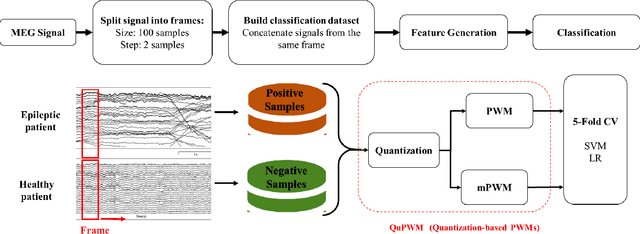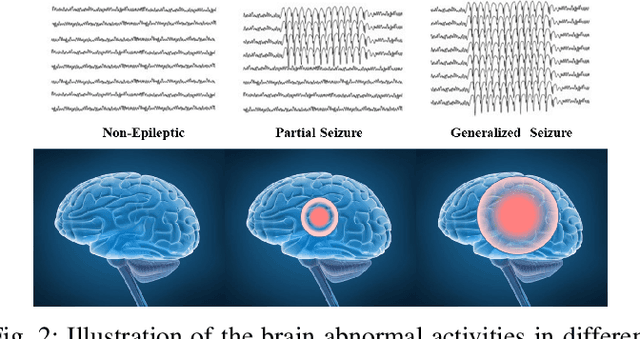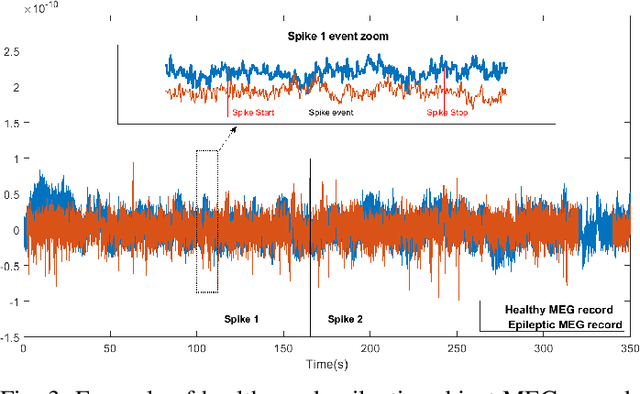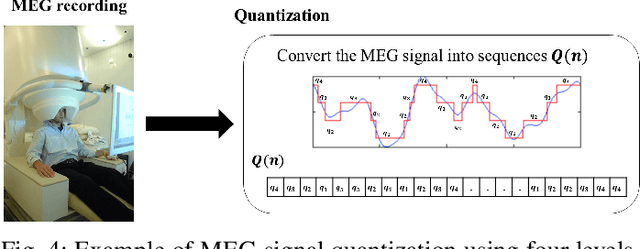Taous-Meriem Laleg-Kirati
Radio-PPG: photoplethysmogram digital twin synthesis using deep neural representation of 6G/WiFi ISAC signals
Sep 26, 2025Abstract:Digital twins for 1D bio-signals enable real-time monitoring of physiological processes of a person, which enables early disease diagnosis and personalized treatment. This work introduces a novel non-contact method for digital twin (DT) photoplethysmogram (PPG) signal synthesis under the umbrella of 6G/WiFi integrated sensing and communication (ISAC) systems. We employ a software-defined radio (SDR) operating at 5.23 GHz that illuminates the chest of a nearby person with a wideband 6G/WiFi signal and collects the reflected signals. This allows us to acquire Radio-PPG dataset that consists of 300 minutes worth of near synchronous 64-channel radio data, PPG data, along with the labels (three body vitals) of 30 healthy subjects. With this, we test two artificial intelligence (AI) models for DT-PPG signal synthesis: i) discrete cosine transform followed by a multi-layer perceptron, ii) two U-NET models (Approximation network, Refinement network) in cascade, along with a custom loss function. Experimental results indicate that U-NET model achieves an impressive relative mean absolute error of 0.194 with a small ISAC sensing overhead of 15.62%, for DT-PPG synthesis. Furthermore, we performed quality assessment of the synthetic DT-PPG by computing the accuracy of DT-PPG-based vitals estimation and feature extraction, which turned out to be at par with that of reference PPG-based vitals estimation and feature extraction. This work highlights the potential of generative AI and 6G/WiFi ISAC technologies and serves as a foundational step towards the development of non-contact screening tools for covid-19, cardiovascular diseases and well-being assessment of people with special needs.
Image contrast enhancement based on the Schrödinger operator spectrum
Jun 04, 2024Abstract:This study proposes a novel image contrast enhancement method based on image projection onto the squared eigenfunctions of the two dimensional Schr\"odinger operator. This projection depends on a design parameter \texorpdfstring{\(\gamma\)}{gamma} which is proposed to control the pixel intensity during image reconstruction. The performance of the proposed method is investigated through its application to color images. The selection of \texorpdfstring{\(\gamma\)}{gamma} values is performed using k-means, which helps preserve the image spatial adjacency information. Furthermore, multi-objective optimization using the Non dominated Sorting Genetic Algorithm II (NSAG2) algorithm is proposed to select the optimal values of \texorpdfstring{\(\gamma\)}{gamma} and the semi-classical parameter h from the 2DSCSA. The results demonstrate the effectiveness of the proposed method for enhancing image contrast while preserving the inherent characteristics of the original image, producing the desired enhancement with almost no artifacts.
Non-Contact Acquisition of PPG Signal using Chest Movement-Modulated Radio Signals
Feb 22, 2024Abstract:We present for the first time a novel method that utilizes the chest movement-modulated radio signals for non-contact acquisition of the photoplethysmography (PPG) signal. Under the proposed method, a software-defined radio (SDR) exposes the chest of a subject sitting nearby to an orthogonal frequency division multiplexing signal with 64 sub-carriers at a center frequency 5.24 GHz, while another SDR in the close vicinity collects the modulated radio signal reflected off the chest. This way, we construct a custom dataset by collecting 160 minutes of labeled data (both raw radio data as well as the reference PPG signal) from 16 healthy young subjects. With this, we first utilize principal component analysis for dimensionality reduction of the radio data. Next, we denoise the radio signal and reference PPG signal using wavelet technique, followed by segmentation and Z-score normalization. We then synchronize the radio and PPG segments using cross-correlation method. Finally, we proceed to the waveform translation (regression) task, whereby we first convert the radio and PPG segments into frequency domain using discrete cosine transform (DCT), and then learn the non-linear regression between them. Eventually, we reconstruct the synthetic PPG signal by taking inverse DCT of the output of regression block, with a mean absolute error of 8.1294. The synthetic PPG waveform has a great clinical significance as it could be used for non-contact performance assessment of cardiovascular and respiratory systems of patients suffering from infectious diseases, e.g., covid19.
You can monitor your hydration level using your smartphone camera
Feb 12, 2024Abstract:This work proposes for the first time to utilize the regular smartphone -- a popular assistive gadget -- to design a novel, non-invasive method for self-monitoring of one's hydration level on a scale of 1 to 4. The proposed method involves recording a small video of a fingertip using the smartphone camera. Subsequently, a photoplethysmography (PPG) signal is extracted from the video data, capturing the fluctuations in peripheral blood volume as a reflection of a person's hydration level changes over time. To train and evaluate the artificial intelligence models, a custom multi-session labeled dataset was constructed by collecting video-PPG data from 25 fasting subjects during the month of Ramadan in 2023. With this, we solve two distinct problems: 1) binary classification (whether a person is hydrated or not), 2) four-class classification (whether a person is fully hydrated, mildly dehydrated, moderately dehydrated, or extremely dehydrated). For both classification problems, we feed the pre-processed and augmented PPG data to a number of machine learning, deep learning and transformer models which models provide a very high accuracy, i.e., in the range of 95% to 99%. We also propose an alternate method where we feed high-dimensional PPG time-series data to a DL model for feature extraction, followed by t-SNE method for feature selection and dimensionality reduction, followed by a number of ML classifiers that do dehydration level classification. Finally, we interpret the decisions by the developed deep learning model under the SHAP-based explainable artificial intelligence framework. The proposed method allows rapid, do-it-yourself, at-home testing of one's hydration level, is cost-effective and thus inline with the sustainable development goals 3 & 10 of the United Nations, and a step-forward to patient-centric healthcare systems, smart homes, and smart cities of future.
Feeding control and water quality monitoring in aquaculture systems: Opportunities and challenges
Jun 14, 2023Abstract:Aquaculture systems can benefit from the recent development of advanced control strategies to reduce operating costs and fish loss and increase growth production efficiency, resulting in fish welfare and health. Monitoring the water quality and controlling feeding are fundamental elements of balancing fish productivity and shaping the fish growth process. Currently, most fish-feeding processes are conducted manually in different phases and rely on time-consuming and challenging artificial discrimination. The feeding control approach influences fish growth and breeding through the feed conversion rate; hence, controlling these feeding parameters is crucial for enhancing fish welfare and minimizing general fishery costs. The high concentration of environmental factors, such as a high ammonia concentration and pH, affect the water quality and fish survival. Therefore, there is a critical need to develop control strategies to determine optimal, efficient, and reliable feeding processes and monitor water quality. This paper reviews the main control design techniques for fish growth in aquaculture systems, namely algorithms that optimize the feeding and water quality of a dynamic fish growth process. Specifically, we review model-based control approaches and model-free reinforcement learning strategies to optimize the growth and survival of the fish or track a desired reference live-weight growth trajectory. The model-free framework uses an approximate fish growth dynamic model and does not satisfy constraints. We discuss how model-based approaches can support a reinforcement learning framework to efficiently handle constraint satisfaction and find better trajectories and policies from value-based reinforcement learning.
Spatial Distribution Patterns of Clownfish in Recirculating Aquaculture Systems
Dec 29, 2021



Abstract:Monitoring and detecting fish behaviors provide essential information on fish welfare and contribute to achieving intelligent production in global aquaculture. This work proposes an efficient approach to analyze the spatial distribution status and motion patterns of juvenile clownfish (Amphiprion bicinctus) maintained in aquaria at three stocking densities (1, 5, and 10 individuals/aquarium). The estimated displacement is the key factor in assessing the dispersion and velocity to express the clownfish's spatial distribution and movement behavior in a recirculating aquaculture system. Indeed, we aim at computing the velocity, magnitude, and turning angle using an optical flow method to assist aquaculturists in efficiently monitoring and identifying fish behavior. We test the system design on a database containing two days of video streams of juvenile clownfish maintained in aquaria. The proposed displacement estimation reveals good performance in measuring clownfish's motion and dispersion characteristics. Furthermore, we demonstrate the effectiveness of the proposed technique for quantifying variation in clownfish activity levels between recordings taken in the morning and afternoon.
QuPWM: Feature Extraction Method for MEG Epileptic Spike Detection
Jul 03, 2019



Abstract:Epilepsy is a neurological disorder classified as the second most serious neurological disease known to humanity, after stroke. Localization of the epileptogenic zone is an important step for epileptic patient treatment, which starts with epileptic spike detection. The common practice for spike detection of brain signals is via visual scanning of the recordings, which is a subjective and a very time-consuming task. Motivated by that, this paper focuses on using machine learning for automatic detection of epileptic spikes in magnetoencephalography (MEG) signals. First, we used the Position Weight Matrix (PWM) method combined with a uniform quantizer to generate useful features. Second, the extracted features are classified using a Support Vector Machine (SVM) for the purpose of epileptic spikes detection. The proposed technique shows great potential in improving the spike detection accuracy and reducing the feature vector size. Specifically, the proposed technique achieved average accuracy up to 98\% in using 5-folds cross-validation applied to a balanced dataset of 3104 samples. These samples are extracted from 16 subjects where eight are healthy and eight are epileptic subjects using a sliding frame of size of 100 samples-points with a step-size of 2 sample-points
 Add to Chrome
Add to Chrome Add to Firefox
Add to Firefox Add to Edge
Add to Edge